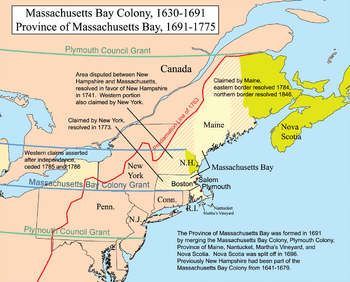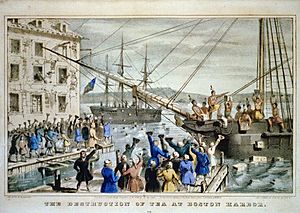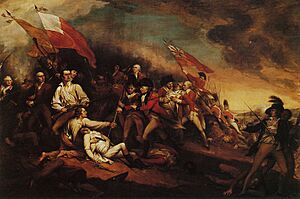Province of Massachusetts Bay facts for kids
Quick facts for kids
Province of Massachusetts Bay
|
|||||||||||||||||
|---|---|---|---|---|---|---|---|---|---|---|---|---|---|---|---|---|---|
| 1691–1776 | |||||||||||||||||
|
Anthem:
God Save the King (1745–1774) |
|||||||||||||||||

Map depicting the colonial claims related to the province
|
|||||||||||||||||
| Capital | Boston | ||||||||||||||||
| Common languages | English, French, Massachusett, Mi'kmaq | ||||||||||||||||
| Religion | Congregationalism | ||||||||||||||||
| Government | Self-governing colony (1691–1774) Crown colony (1774) Provisional government (1774–1780) |
||||||||||||||||
| Monarch | |||||||||||||||||
|
• 1691–1694
|
William III & Mary II | ||||||||||||||||
|
• 1760–1776
|
George III | ||||||||||||||||
| Governor | |||||||||||||||||
|
• 1692–1694
|
Sir William Phips | ||||||||||||||||
|
• 1774–1775
|
Thomas Gage | ||||||||||||||||
| President of the Congress | |||||||||||||||||
|
• 1774–1775
|
John Hancock | ||||||||||||||||
|
• 1775
|
Joseph Warren | ||||||||||||||||
|
• 1775–1780
|
James Warren | ||||||||||||||||
| Legislature | Great and General Court (1691–1774) Massachusetts Provincial Congress (1774–1780) |
||||||||||||||||
| Historical era | British colonization of the Americas American Revolution |
||||||||||||||||
|
• Massachusetts Charter issued
|
October 7, 1691 | ||||||||||||||||
| May 20, 1774 | |||||||||||||||||
|
• Provincial Congress established
|
October 4, 1774 | ||||||||||||||||
|
• Massachusetts Declaration of Independence
|
May 1, 1776 | ||||||||||||||||
|
• Massachusetts Constitution adopted
|
October 25, 1780 | ||||||||||||||||
| Currency | Massachusetts pound, Spanish dollar, US Dollar | ||||||||||||||||
|
|||||||||||||||||
| Today part of | Canada United States |
||||||||||||||||
The Province of Massachusetts Bay was an important colony in New England. It later became one of the original thirteen states of the United States. This colony was officially created on October 7, 1691.
It was formed by King William III and Queen Mary II of England. They combined several earlier British colonies in the New England area. The new charter started on May 14, 1692. It included the Massachusetts Bay Colony, Plymouth Colony, Province of Maine, Martha's Vineyard, Nantucket, Nova Scotia, and New Brunswick. Today, the Commonwealth of Massachusetts is its direct successor. Maine became a separate state in 1820. Nova Scotia and New Brunswick are now parts of Canada. They were only part of the colony until 1697.
The name Massachusetts comes from the Massachusett Indians. They were an Algonquian tribe. The name means "at the great hill" or "at the place of large hills." This refers to the Blue Hills and Great Blue Hill.
Contents
History of the Massachusetts Bay Colony
| Historical population | ||
|---|---|---|
| Year | Pop. | ±% |
| 1700 | 55,941 | — |
| 1710 | 62,390 | +11.5% |
| 1720 | 91,008 | +45.9% |
| 1730 | 114,116 | +25.4% |
| 1740 | 151,613 | +32.9% |
| 1750 | 188,000 | +24.0% |
| 1760 | 220,600 | +17.3% |
| 1770 | 266,565 | +20.8% |
| 1780 | 317,760 | +19.2% |
| Source: 1700–1760; 1770–1780 including District of Maine | ||
Early Settlements and Growth
English settlers first arrived in Massachusetts Bay in 1620. They founded the Plymouth Colony. More settlements began in 1628 with the Massachusetts Bay Colony. Many Puritan settlers arrived in 1630. Over the next ten years, many Puritans moved to New England. This led to new colonies forming.
By the 1680s, there were five main New England colonies. These included Connecticut Colony, Colony of Rhode Island and Providence Plantations, and Province of New Hampshire. Massachusetts Bay was the largest and richest. It had many merchant ships.
Conflicts with Native Americans
The colonists had problems with some Indigenous peoples. The Pequot tribe was almost wiped out in the Pequot War in the 1630s. King Philip's War in the 1670s greatly harmed the Narragansetts. This war was also very costly for the colonists. It stopped their expansion for several years.
Growing Tensions with England
In their early days, Massachusetts and Plymouth were quite independent. But this changed after Charles II became king in 1660. He wanted more control over the colonies. He tried to control their trade.
The Navigation Acts were passed in the 1660s. These laws were unpopular in Massachusetts. Merchants often found them unfair. King Charles II also saw Massachusetts making its own coins as an act of treason. Many colonial governments did not enforce these laws. Tensions grew when Charles took back the first Massachusetts Charter in 1684.
The Dominion of New England
In 1686, King James II created the Dominion of New England. This joined all British lands from Delaware to Maine into one unit. The Dominion governor, Sir Edmund Andros, was very disliked. He made colonists angry by strictly enforcing trade laws. He also took land titles and limited town meetings.
When James II was removed from power in the 1688 Glorious Revolution, Massachusetts leaders arrested Andros. This caused the Dominion to fall apart. Other colonies quickly went back to their old governments.
A New Royal Charter
Plymouth Colony never had a royal charter. Its government was always uncertain. Massachusetts' government was restarted, but its old charter was gone. Some people refused to pay taxes.
Colonial agents went to London. Increase Mather asked King William III and Mary II to restore the old charter. The king refused because he feared a return to strict religious rule. Instead, the Lords of Trade combined Plymouth and Massachusetts Bay. They formed the Province of Massachusetts Bay. The new charter was issued on October 7, 1691. Sir William Phips was named its first governor.
The Provincial Charter: New Rules
The new charter was different from the old one in several important ways.
Changes to Voting and Government
One big change was about voting rights. Before, only church members could vote. Now, men who owned enough land could vote. This meant many more men could vote. To vote, a man needed property worth £40 or land that earned £2 a year in rent. Historians believe this included about three-quarters of adult men. The charter also allowed freedom of worship for all non-Catholic Christians.
Another major change was how leaders were chosen. The king appointed the governor, lieutenant governor, and judges. The legislative assembly, called the General Court, was still elected. This assembly chose members of the Governor's Council. The governor could veto laws passed by the General Court. He could also veto council appointments.
These rules were different from other New England colonies. The General Court now controlled spending. The council was chosen locally, not by the king or governor. These changes made the governor's power weaker. This became important later on.
Expanded Territory
The province's land was much larger than the original Massachusetts and Plymouth colonies. It included mainland Massachusetts, western Maine, and parts of New Hampshire. It also added Acadia (now Nova Scotia, New Brunswick, and eastern Maine). Plus, it included Dukes County from Province of New York. This area had Nantucket, Martha's Vineyard, and the Elizabeth Islands.
Life in the Colonial Era
Wars and Financial Troubles
After the revolt against Andros, frontier defenses were weak. French and Indigenous forces from Canada and Acadia often raided settlements. Queen Anne's War began in 1702 and lasted until 1713. Massachusetts Governor Joseph Dudley organized defenses, which reduced raids. Dudley also led attacks on Acadia, a base for French privateers.
Because of these wars, the colony printed paper money. Its value kept falling, causing money problems. People suggested creating a bank to issue notes backed by land. Governors Dudley and Samuel Shute opposed this. They also tried to get the assembly to set fixed salaries for royal officials, but they failed.
In the early 1720s, the Abenaki people raided frontier towns. They were encouraged by the French. They were also worried about English settlers taking their land. Acting Governor William Dummer ended this violence in Dummer's War. Many Abenakis moved to Canada after the conflict.
Governors and Disputes
In the 1730s, Governor Jonathan Belcher argued with the legislature. He wanted to control how money was spent. He would veto bills that limited his power. This often left the provincial treasury empty. Belcher was allowed to accept yearly payments from the legislature instead of a fixed salary.
The money crisis returned during his time. The idea of a land bank came up again, but Belcher was against it. His opponents worked in London to have him removed. The bank was created, but Parliament quickly closed it. This made many important colonists angry at the king and Parliament. One of them was the father of Samuel Adams, a future leader of the American Revolutionary War.
More Wars and Growing Discontent
The next 20 years were filled with war. King George's War started in 1744. Governor William Shirley gathered troops from New England. They attacked the French fortress at Louisbourg and captured it in 1745. However, Louisbourg was given back to France in 1748. This angered New Englanders.
Governor Shirley was popular because he avoided big arguments. The French and Indian War began in 1754. Shirley became a top military commander. But he struggled to manage the war's logistics and was recalled in 1757. His replacement, Thomas Pownall, oversaw the rest of the war, which ended in 1760.
The American Revolution Begins
Rising Frustration and Taxes
The 1760s and early 1770s saw growing anger in the colonies. People were frustrated with London's policies and the governors who enforced them. Governors Francis Bernard and Thomas Hutchinson were widely disliked. A major issue was Parliament trying to tax the colonies without their consent.
Hutchinson was from Massachusetts. He allowed British soldiers to stay in Boston. This led to the Boston Massacre on March 5, 1770. By this time, Samuel Adams, Paul Revere, John Hancock, and others were actively against the king's policies.
Protests and Dissolution of the Legislature
Parliament passed the Townshend Acts in 1767 and 1768. Americans called them the Intolerable Acts. The Massachusetts General Court wrote a letter saying these acts were against their rights. Governor Bernard demanded they take back the letter, but they refused. So, he dissolved the General Court. This led to riots in Boston. Royal officers fled to Castle William. The king sent more troops to Massachusetts.
The Sons of Liberty were ready to fight. More moderate people wanted a peaceful solution. Boston citizens decided to hold a convention of Massachusetts towns. Delegates met at Faneuil Hall in September. They voted against military action.
The Boston Tea Party
In 1773, the Sons of Liberty held a meeting at the Old South Meeting House in Boston. This was against the Tea Act. Thousands attended, and Samuel Adams organized a protest. Colonists boarded ships in the harbor and threw tea into the water. This event became known as the Boston Tea Party.
General Thomas Gage became the new royal governor in May 1774. He was first welcomed. But his reputation quickly worsened as he enforced the Intolerable Acts. These acts included the Massachusetts Government Act. This act dissolved the legislature. It also closed Boston's port until the tea was paid for. The port closure hurt Massachusetts' economy. Other colonies sent help in sympathy.
The Provincial Congress Takes Control
The Intolerable Acts made the crisis in New England worse. Boston colonists felt their rights were being destroyed. New England colonies had democratic control of their governments since 1620. The General Court had power over money and laws. The royal governor could veto laws, but the General Court could stop his pay. This made the governor's power very weak.
The royal government of Massachusetts Bay lasted until October 1774. Then, members of the General Court met against the Massachusetts Government Act. They formed the Massachusetts Provincial Congress. This became the real government. Governor Gage still held military power in Boston. But the Provincial Congress governed the rest of Massachusetts.
The Start of the Revolutionary War
War finally broke out in April 1775. The Battles of Lexington and Concord began the American Revolutionary War and the Siege of Boston. British troops left Boston on March 17, 1776. This ended the siege and brought the city under Patriot control.
On May 1, 1776, the General Assembly declared independence. They did so in the name of "The Government and People of the Massachusetts Bay in New England." This was followed by the United States Declaration of Independence on July 4, 1776. This declared the independence of all Thirteen Colonies.
The Massachusetts Provincial Congress
When the Massachusetts Government Act dissolved the General Court, colonists held conventions. These were organized by county, with delegates from each town. They sent resolutions to the Royal Governor. They demanded their constitutional government be restored. This government had existed since the Mayflower Compact of 1620.
They declared loyalty to King George III. But they said they would break this loyalty if their rights were not restored. They threatened to resist with force. This included boycotting British goods and disrupting local courts.
Delegates from all Massachusetts counties met in Salem in October 1774. They reformed their dissolved assembly. This new congress was meant to restart their constitutional government. It rejected the royal government in Boston. The congress chose John Hancock as its first president. They also appointed judges, tax collectors, and other officials. They took control of the militia. They told towns to train troops and elect new officers. A Committee of Safety was also created to govern when Congress was not meeting.
The Provincial Congress changed over its six years. The Committee of Safety became the main governing body. It was in charge of the militia and governance between sessions. Joseph Warren was elected the second president. James Warren was the third.
Forming the Commonwealth of Massachusetts
The Push for a New Constitution
Calls for a constitutional convention began in 1774. But the war and political uncertainty delayed these efforts. Berkshire County in western Massachusetts strongly wanted a new constitution. Delegates from Pittsfield rejected both royal authority and the old charters. They said a state's legitimacy came only from its people.
After Massachusetts Bay declared independence in May 1776, the push for a new constitution grew. In September 1776, the General Court asked towns to vote on holding a convention. In 1777, it was agreed to form a convention to write a new constitution. The General Court decided a committee would write it.
Drafting and Adopting the Constitution
In 1778, the General Court decided the draft would be voted on by the people. It needed two-thirds of voters to accept it. The first draft was rejected. This draft had a two-house legislature. The governor would have no veto power. It also had no Bill of Rights. It was rejected by a large margin (83% to 17%).
In 1779, people were asked if they wanted another convention. This time, it would be based on population. The idea passed (72% to 28%). This new convention met from September 1779 to June 1780. The war was not going well for the Patriot forces. But the convention still assembled with 312 members.
John Adams wrote the new constitution's draft. The convention accepted it with few changes. The draft was then sent to the various town meetings. Towns voted on parts of the constitution and suggested changes. The Adams version was accepted by the convention on June 15, 1780. In October 1780, John Hancock was elected the first Governor of Massachusetts. Representatives were also elected to the commonwealth's first General Court.
Geography and Borders
The borders of the province changed over time. The land had thin soil and a rocky terrain.
Changes in Territory
Nova Scotia, including New Brunswick, was held by English forces when the charter was issued. But it was returned to France in 1697 by the Treaty of Ryswick. Nova Scotia became a separate province in 1710. This happened after the British captured Acadia in Queen Anne's War. Maine did not become a separate state until 1820, after American independence.
Border Disputes with Neighbors
The borders with neighboring provinces also changed. Massachusetts Bay and Plymouth had set boundaries with New Hampshire, Rhode Island, and Connecticut. But these changed during the provincial period. The border with New Hampshire was debated. The original charter said it was three miles north of the Merrimack River. But they thought the river flowed mostly west. In 1741, King George II ruled that the border would follow what is now the state line.
Surveys in the 1690s showed the border with Connecticut and Rhode Island was wrong. In the early 1700s, new surveys showed the line was too far north. In 1713, Massachusetts gave land called the "Equivalent Lands" to Connecticut as payment. These lands were sold, and the money helped fund Yale College.
The border with Rhode Island also needed fixing. In 1746, lands on the eastern side of Narragansett Bay were given to Rhode Island. These included present-day Barrington, Bristol, Tiverton, and Little Compton. The borders with Massachusetts' southern neighbors were not finalized until the 1800s. The western border with New York was agreed upon in 1773 but surveyed in 1788.
The Province of Massachusetts Bay also claimed land in what is now Western New York. This was part of its "sea-to-sea grant." In the 1780s, the Treaty of Hartford made Massachusetts give up this claim. In return, it got the right to sell the land to developers.
Images for kids
See also
 In Spanish: Provincia de la bahía de Massachusetts para niños
In Spanish: Provincia de la bahía de Massachusetts para niños







